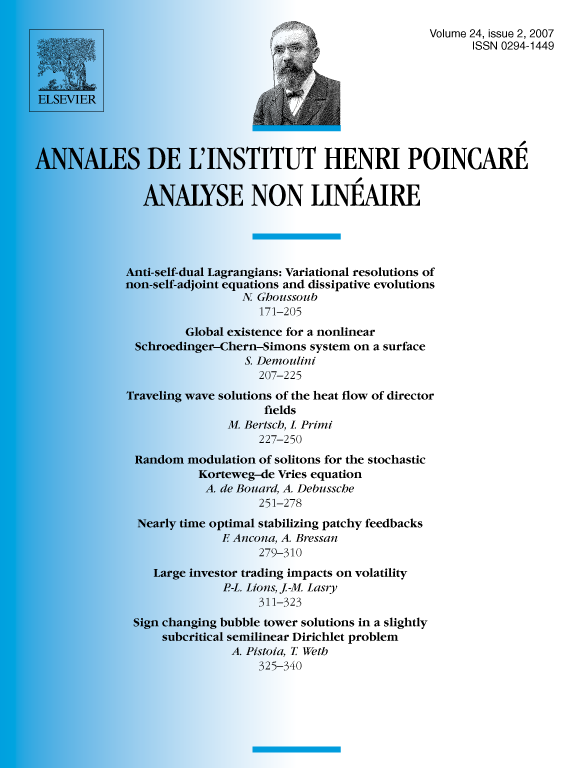Anti-self-dual Lagrangians: Variational resolutions of non-self-adjoint equations and dissipative evolutions
Nassif Ghoussoub
Department of Mathematics, University of British Columbia, Vancouver BC, Canada V6T 1Z2

Abstract
We develop the concept and the calculus of anti-self-dual (ASD) Lagrangians and their derived vector fields which seem inherent to many partial differential equations and evolutionary systems. They are natural extensions of gradients of convex functions – hence of self-adjoint positive operators – which usually drive dissipative systems, but also provide representations for the superposition of such gradients with skew-symmetric operators which normally generate unitary flows. They yield variational formulations and resolutions for large classes of non-potential boundary value problems and initial-value parabolic equations. Solutions are minima of newly devised energy functionals, however, and just like the self (and anti-self) dual equations of quantum field theory (e.g. Yang–Mills) the equations associated to such minima are not derived from the fact they are critical points of the functional , but because they are also zeroes of suitably derived Lagrangians. The approach has many advantages: it solves variationally many equations and systems that cannot be obtained as Euler–Lagrange equations of action functionals, since they can involve non-self-adjoint or other non-potential operators; it also associates variational principles to variational inequalities, and to various dissipative initial-value first order parabolic problems. These equations can therefore be analyzed with the full range of methods – computational or not – that are available for variational settings. Most remarkable are the permanence properties that ASD Lagrangians possess making their calculus relatively manageable and their domain of applications quite broad.
Résumé
On introduit et développe la notion de Lagrangien anti-autodual qui apparait dans plusieurs problèmes de géométrie et de physique théorique. Cette classe inclut les champs de gradient de fonctions convexes qui sont à la base de systèmes dissipatifs, mais aussi la superposition de ces derniers avec les opérateurs anti-symétriques qui, par contre, engendrent des flots conservatifs. Comme pour les équations autoduales de Yang–Mills, ces Lagrangiens permettent la résolution variationnelle de plusieurs équations différentielles du premier ordre qui ne rentrent donc pas dans le cadre de la théorie de Euler–Lagrange. Les solutions proviennent de minima de certaines (nouvelles) fonctionelles d'énergie, mais les équations ne sont pas derivées du fait qu'elles sont des points critiques, mais du fait qu'elles sont des racines de Lagrangiens positifs associés obtenus par une extension d'une astuce de Bogomolnyi. Cette nouvelle approche variationelle a plusieurs avantages, surtout qu'elle est applicable dans plusieurs situations, puisque la classe des Lagrangiens anti-autoadjoints est assez riche, étant stable – entre autres – par les opérations du calcul fonctionnel de l'analyse convexe, ainsi que celui des opérateurs anti-symétriques.
Cite this article
Nassif Ghoussoub, Anti-self-dual Lagrangians: Variational resolutions of non-self-adjoint equations and dissipative evolutions. Ann. Inst. H. Poincaré Anal. Non Linéaire 24 (2007), no. 2, pp. 171–205
DOI 10.1016/J.ANIHPC.2006.02.002